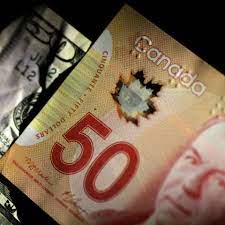The Canadian Dollar (CAD) experienced
The Canadian Dollar (CAD) experienced a notable decline on Tuesday, weakening across the board and losing approximately 0.2% of its value against the US Dollar (USD) following the release of Canada’s Consumer Price Index (CPI) inflation data for April. This development has led to increased speculation among market participants that the Bank of Canada (BoC) may implement a rate cut in June.
The latest CPI data revealed that Canadian
The latest CPI data revealed that Canadian inflation has eased, aligning closely with market expectations. However, the BoC’s Core CPI, which strips out volatile items and provides a clearer picture of underlying inflation trends, dropped to its lowest level since April 2021. This significant decrease in core inflation has heightened market anticipations of a rate cut, with the probability of such an action in June rising to 48%, up from 40% before the release of the CPI data.
Canadian Dollar Performance Against Major Currencies
The table below illustrates the percentage change in the value of the Canadian Dollar (CAD) against several major currencies on Tuesday. Among these, the CAD showed the greatest strength against the New Zealand Dollar (NZD).
| USD | EUR | GBP | JPY | CAD | AUD | NZD | CHF | |
|---|---|---|---|---|---|---|---|---|
| USD | 0.00% | -0.04% | -0.08% | 0.16% | 0.01% | 0.16% | 0.00% | |
| EUR | -0.01% | -0.04% | -0.08% | 0.14% | 0.04% | 0.13% | 0.01% | |
| GBP | 0.04% | 0.04% | -0.06% | 0.20% | 0.05% | 0.19% | 0.04% | |
| JPY | 0.08% | 0.08% | 0.06% | 0.25% | 0.08% | 0.22% | 0.08% | |
| CAD | -0.16% | -0.14% | -0.20% | -0.25% | -0.15% | -0.01% | -0.16% | |
| AUD | -0.01% | -0.04% | -0.05% | -0.08% | 0.15% | 0.14% | 0.00% | |
| NZD | -0.16% | -0.13% | -0.19% | -0.22% | 0.01% | -0.14% | -0.15% | |
| CHF | -0.00% | -0.01% | -0.04% | -0.08% | 0.16% | 0.00% | 0.15% |
The CAD’s decline was most pronounced against the Japanese Yen (JPY), which saw a broad recovery. The CAD fell by 0.3% against the JPY and lost 0.2% against the USD.
Technical Analysis: CAD in Familiar Territory
From a technical analysis perspective, the Canadian Dollar has moved into a downward trend, slipping against nearly all major currency counterparts. The USD/CAD pair climbed to its highest level in a week, indicating a potential bullish breakout from the 50-day Exponential Moving Average (EMA) at 1.3636. Although the pair remains below the peaks observed last month near 1.3850, a long-term support level is established at the 200-day EMA around 1.3549.
The recent movements in the USD/CAD pair suggest that traders are positioning for continued strength in the USD, driven by contrasting economic indicators and policy expectations between Canada and the United States. The US economy has shown resilience, while Canada’s economic outlook has been tempered by the easing inflation pressures and potential rate cuts.
Implications of the CPI Data and BoC Rate Cut Speculations
The easing of CPI inflation in Canada underscores a deceleration in price growth, which can be attributed to various factors such as lower energy prices and moderated demand pressures. The Core CPI’s significant drop further indicates that underlying inflationary pressures are waning. This scenario supports the case for the BoC to adopt a more accommodative monetary policy stance, potentially reducing interest rates to spur economic activity.
A rate cut by the BoC in June would
A rate cut by the BoC in June would mark a shift from its previous tightening cycle aimed at controlling inflation. Lower interest rates generally make a currency less attractive to investors seeking higher returns, leading to depreciation. Hence, the increased likelihood of a rate cut has weighed on the CAD as investors recalibrate their expectations and investment strategies.
Broader Market Context
The Canadian Dollar’s performance should also be viewed in the context of broader market trends. Global financial markets are currently navigating a complex environment characterized by divergent economic recoveries, varying inflation dynamics, and differing central bank policies. While the US Federal Reserve has signaled a potential pause in its rate hikes, it has maintained a relatively hawkish stance compared to the BoC, further boosting the USD against the CAD.
Commodity prices, particularly oil, also play a crucial role in the CAD’s valuation given Canada’s status as a major oil exporter. Recent fluctuations in oil prices have contributed to the CAD’s volatility. However, the primary driver of the CAD’s recent weakness appears to be the changing expectations around BoC’s monetary policy.
Conclusion
The Canadian Dollar has faced broad-based pressure on Tuesday, driven by the easing of CPI inflation and heightened market expectations of a rate cut by the Bank of Canada in June. This development has led to the CAD depreciating against major currencies, particularly the USD and JPY. From a technical perspective, the USD/CAD pair is testing significant resistance levels, suggesting potential further weakness for the CAD.
The evolving economic landscape and central bank policies will continue to influence the CAD’s performance in the near term. Investors will be closely monitoring upcoming economic data and BoC communications for further clues on the direction of monetary policy and its implications for the Canadian Dollar.
